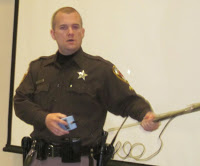Project Lifesaver tracks wandering Alzheimer’s victims
 |
| Hofrichter demonstrates the Project Lifesaver antenna |
If there’s someone in your household with a tendency to wander off and get lost, you might want to check into Project Lifesaver, a program that uses radio-controlled monitors to locate missing persons. The program is designed for people with Alzheimer’s, dementia, autism, Down’s syndrome, or similar conditions.
Clients wear a personalized wristband or ankle band that emits an invisible signal. When they get lost, the Sheriff’s Office sends a search and rescue team to find them, using specialized tracking equipment.
Deputies Marc Hofrichter and Alex Fogle explained the program at a meeting of the Mason Police District’s Citizens Advisory Committee last week.
In more than 1,500 nationwide Project Lifesaver searches, there have no serious injuries or deaths, Hofrichter says. Without a program like this, many people with Alzheimer’s would be difficult to find if they wander, as they typically are unaware of their situation and do not call out for help or respond to people calling to them.
With Project Lifesaver, it usually takes 30 minutes or less to track down a missing client, Hofrichter says. The Fairfax County program has 48 clients—about half of them juveniles, and there are six or seven on the waiting list, he says. The Sherriff’s Office usually does about five searches a year. The program is totally supported by federal grants and donations—not tax dollars.
The monitors are less effective with indoor searches, but searchers were able to find someone inside a dumpster, he says. “It’s a good feeling to find someone and bring him home.”

